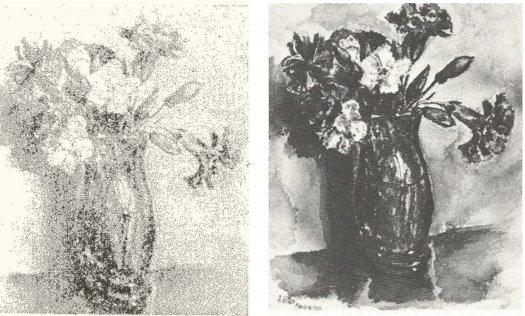|
|
||||||
|
November 15,
2020 - Droog Magazine periodical for investigative
journalism The strange business of selling fakes, forgeries and other concoctions attributed to Adolf Hitler (1889-1945) and other Nazi criminals. Introduction
Charles Hamilton and the Hitlers March 23, 1978, New York - Charles Hamilton Galleries, an auction house run by the American handwriting expert Charles Hamilton, sold an alleged Hitler watercolor for $4,500 (about £2,350).
Again, this is quite startling information. If the year mentioned in The Times, "1912", is correct, then apparently neither Charles Hamilton nor "art expert" Peter Jahn knew that it branded the watercolor as a forgery - for Hitler emigrated to Munich in May 1913!  Black and white reproductions of the auctioned work, in The Times (left) and in Price (right). But maybe the "1912" in The Times article is a typo. For in the book Adolf Hitler als Maler und Zeichner (a.k.a. as Price or Werkkatalog), compiled by Jahn and August Priesack, this work is depicted too, as # 302, with as description "Signed and dated "A. Hitler, München 1913"". Unfortunately, neither on the photo published in The Times, nor on the one in Price the year can be seen. Now, "art expert" Peter Jahn was a professional swindler, already before the Second World War involved in the trade of fake Hitlers. As he stated in 1978 that he never had seen a Hitler flower still life before, then the 1978 still life must have boosted the production of similar works, as in Price a great number of still lifes are depicted. And how about Charles Hamilton? He was an autograph expert, for handwritten autographs. He was definitely not an art expert, ignorant of the fact that painted signatures are very easy to forge. Drs. P.L. Zevenbergen, Chief Constable (retired) of the The Hague Police, handwriting expert, formerly working for the 'Judicial Laboratory Rijswijk' (the forerunner of the Netherlands Forensic Institute) and involved in the investigation of the falsified Hitler diaries in 1983, stated that a signature on a watercolor is not suitable for identification purposes, for several reasons, remarked about signatures on painted works:
Hitler flower painting sold for $4,500. The Times, London, 25-03-1978. https://www.thetimes.co.uk/archive/article/1978-03-25/16/8.html?region=global#start%3D1785-01-01%26end%3D1985-12-31%26terms%3Dauction%20hitler%20%26back%3D/tto/archive/find/auction+hitler+/w:1785-01-01%7E1985-12-31/1%26prev%3D/tto/archive/frame/goto/auction+hitler+/w:1785-01-01%7E1985-12-31/9%26next%3D/tto/archive/frame/goto/auction+hitler+/w:1785-01-01%7E1985-12-31/11 Hitler auction banned
Among the objects which the unnamed
collector hoped to sell were a plaque showing Hitler
haranguing a crowd — framed with swastikas and
medals vaunting Nazi Germany's conquests — his hand
drawn family tree, and analbum about the composer Richard Wagner,
given to him as a present in 1933. In brief. Hitler auction banned. The Canberra Times, Canberra (Australia), 24-11-1978. http://nla.gov.au/nla.news-article110925197© Compilation Bart FM Droog, 2020. |
||||||
| |
||||||
| |
